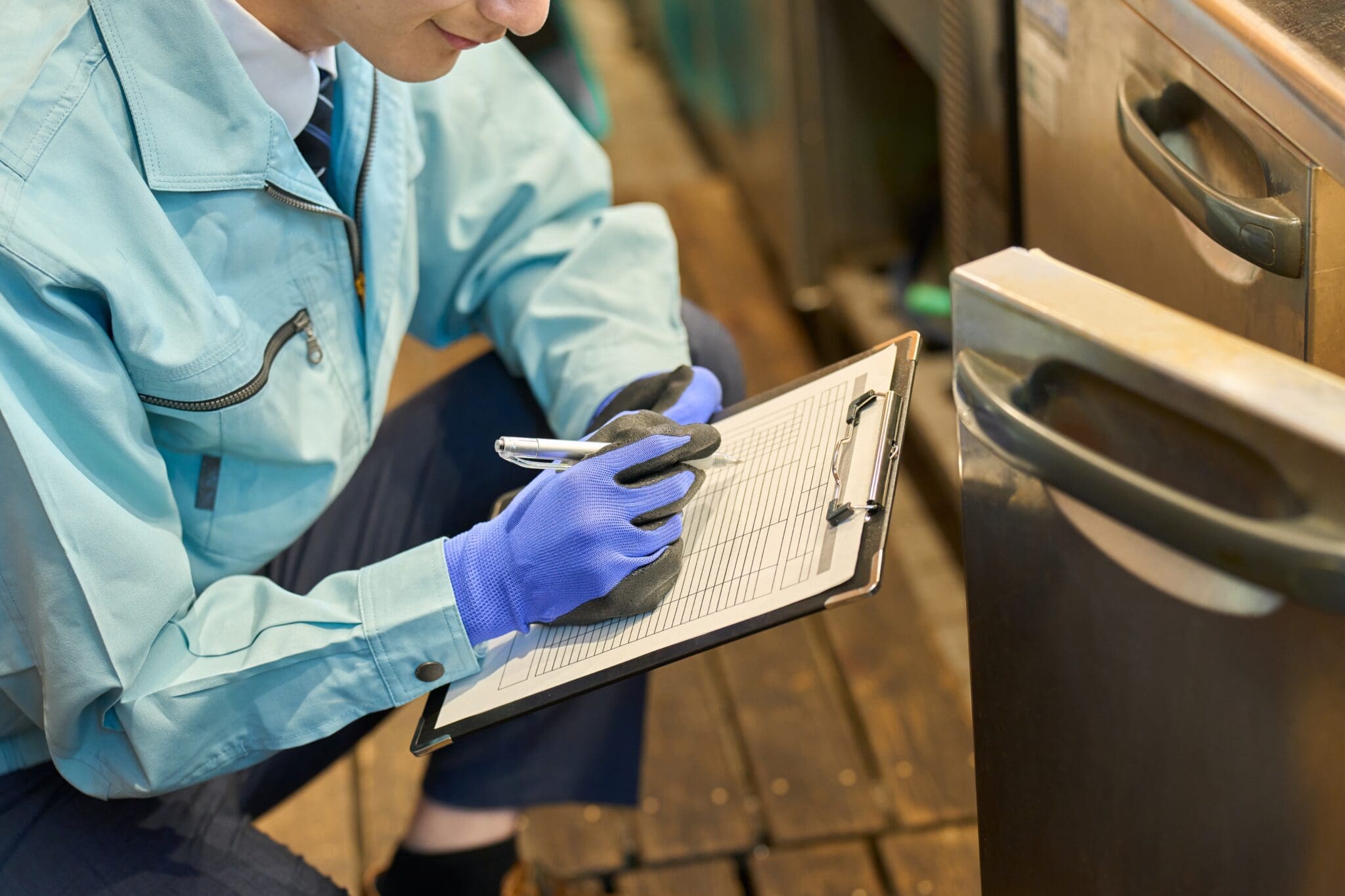In this article
What is a food safety audit?
A food safety audit is a systematic, independent review of a food business’s processes, premises and records to make sure they meet legal hygiene standards and industry best practices.
Unlike a routine inspection, which is typically carried out by a local authority food officer, an audit may be conducted internally by the business itself or externally by a certification body or accredited auditor. Its aim is to:
- Assess the effectiveness of a food safety management system, such as HACCP (hazard analysis and critical control points).
- Identify any gaps or weaknesses before they lead to contamination, customer complaints or enforcement action.
These audits involve detailed checks of food handling practices, equipment maintenance, structural hygiene and staff competence. Auditors follow a predefined checklist or protocol that covers everything from the calibration of thermometers to the correct labelling of allergenic ingredients. They will interview staff, observe operational practices in real time and review records to ensure that documented procedures are being implemented consistently on the shop floor.

Why are food safety audits important?
Food safety audits are critical for:
- Safeguarding consumers’ health
- Protecting a business’s reputation
- Ensuring legal compliance
With an estimated two million cases of foodborne illness per year in the UK, the cost to public health and the economy is substantial. Audits help identify potential hazards – such as cross-contamination, inadequate temperature control or poor personal hygiene – that could lead to outbreaks of illnesses like salmonella, E. coli or campylobacter. Addressing these risks before they materialise is far more efficient and less damaging than managing a full-scale food safety incident.
Audits also demonstrate due diligence and a proactive approach to food safety, which can help businesses get ahead in a competitive market.
Supermarkets, restaurant chains and other major buyers often require audit certificates – such as those issued under the BRCGS or Safe Quality Food (SQF) schemes – before agreeing to supply contracts. A strong audit record can therefore open doors to new business opportunities, while repeated non-conformances can lead to contracts being lost or the withdrawal of buyers’ approvals.
Regulatory enforcement is another key motivation. Under the Food Safety Act 1990 and associated regulations, businesses are obliged to ensure that food is safe and of the nature, substance and quality demanded by the consumer. Failure to meet these obligations can lead to hygiene improvement notices, closure orders or prosecutions.
Types of audits: Internal, external and regulatory
Food safety audits can be categorised broadly into three types, which differ in scope, methodology and consequences.
Internal audits
Internal audits are carried out by trained staff in the business, often as part of ongoing efforts to improve food safety. They follow the company’s own procedures and checklists, which may align with a recognised standard such as ISO 22000 or the retailer’s code of practice.
One of the main benefits of internal audits is that they empower the team to self-identify weaknesses and implement timely corrective actions without waiting for external scrutiny. Well-run internal audit programmes foster a culture of ownership and accountability among staff.
External audits
External audits are performed by independent organisations, such as certification bodies accredited by UKAS (United Kingdom Accreditation Service). These audits evaluate the business against internationally recognised food safety standards (e.g., BRCGS, SQF, IFS).
External audits are typically more rigorous than internal checks, with more serious consequences for non-conformances, including suspension of certification or mandatory follow-up audits.
Achieving certification shows customers, insurers and regulators that the business adheres to globally accepted best practices.
Regulatory inspections
Local authority food safety officers carry out regulatory inspections under statutory powers granted by the Food Safety Act 1990.
Unlike audits, which may be scheduled annually or semi-annually, inspections can be unannounced. Inspectors assess compliance with legal requirements – such as cleanliness, equipment maintenance and staff training – and assign a food hygiene rating under the national Food Hygiene Rating Scheme.
Regulatory inspections have the highest legal weight; failure to comply can result in formal notices, prohibition of operations or prosecution.
UK food safety laws and regulatory bodies
The legislative framework for food safety in the UK is built on the Food Safety Act 1990, which places a clear responsibility on food businesses to make sure the food they sell is safe to eat, accurately described and free from contamination.
Supporting this Act are regulations such as the Food Hygiene (England) Regulations 2013 – and similar laws in Wales, Scotland and Northern Ireland – which set out specific rules for food premises, equipment, waste management, pest control and staff hygiene.
Complementing these are the Food Safety and Hygiene (England) (Amendment) Regulations 2015, which implement the EU’s Regulation (EC) 852/2004 on the hygiene of foodstuffs, with UK-specific adaptations post-Brexit. Under these rules, all food businesses – excluding very low-risk operations – must have a documented, fully implemented HACCP-based food safety management system in place.
Several statutory bodies oversee food safety in the UK:
- The Food Standards Agency (FSA) provides strategic direction, guidance and oversight, while educating consumers and coordinating the national Food Hygiene Rating Scheme.
- Local authorities enforce food law on the ground, conducting inspections and issuing ratings.
- Environmental health officers (EHOs) and trading standards officers ensure compliance, investigate complaints and can take legal action where necessary.
Additional regulators include:
- The Department for Environment, Food & Rural Affairs (Defra), which sets policy on food labelling, animal health and imports
- The Health and Safety Executive (HSE), which covers hazardous substances and workplace risk where they intersect with food safety, such as in the handling of cleaning chemicals
The role of the Food Standards Agency
The Food Standards Agency is the UK government department responsible for protecting public health in relation to food. Established in 2000, the FSA operates across England, Wales and Northern Ireland, working closely with the Food Standards Scotland body for all‐Scotland initiatives.
Its core functions encompass risk assessment, risk management and risk communication on all matters affecting food safety and hygiene.
The FSA does the following:
- Develops evidence-based policies
- Issues guidance for both regulators and food businesses
- Funds research into foodborne pathogens, chemical contaminants and emerging risks such as antimicrobial resistance
- Oversees the national Food Hygiene Rating Scheme, which publishes hygiene scores online to help consumers choose where to eat and encourage businesses to uphold high standards.
Beyond regulation, the FSA promotes best practices through educational campaigns and resources. For example, it has published detailed guides on implementing HACCP, controlling listeria in ready-to-eat foods and managing allergen risks. These resources are freely available on the FSA’s website, providing practical support to businesses of all sizes.
Key areas covered in a food safety audit
A thorough food safety audit looks at several connected areas that together make up a strong food safety management system. The exact scope will depend on the type of audit, but the following core areas are almost always reviewed:
- Premises and equipment – Auditors check the structural condition of walls, floors and ceilings, ensuring surfaces are impervious, washable and free from cracks or holes. Equipment such as refrigerators and freezers must be in good repair, calibrated regularly and suitable for food contact, while non-food equipment (e.g., pallet trucks) should not compromise hygiene zones.
- Food handling practices – Observing day-to-day operations, such as receiving, storage, preparation, cooking and service, verifies that the business is following procedures correctly. This includes checks on hand-washing, glove use, separation of raw and ready-to-eat foods and practices to prevent cross-contamination, such as colour-coded chopping boards.
- Cold chain management – Accurate temperature control is vital for suppressing the growth of pathogenic bacteria. Auditors review temperature logs, calibration certificates for probes and the placement of monitoring devices to ensure that cold rooms, chillers and freezers maintain statutory limits (≤8 °C for chilled storage, ≤–18 °C for frozen).
- HACCP and documentation – A documented HACCP plan must identify critical control points (CCPs), define critical limits and detail corrective actions. Auditors scrutinise records of CCP monitoring, verification activities and management reviews to confirm that the plan is fully implemented and up to date.
- Cleaning and Sanitation – Cleaning schedules should set out the tasks to be done, how often they are carried out, who is responsible and which approved chemicals should be used. Auditors look for evidence of effective cleaning, through, for example, residue checks or ATP swab results. They also check that chemicals are stored safely, with appropriate COSHH (Control of Substances Hazardous to Health) assessments.
- Pest control – Inspectors will look out for contracts with accredited pest control providers, records of inspections, evidence of baiting and proofing measures and absence of pest activity (droppings, gnaw marks, live sightings).
- Personal hygiene and training – Staff should receive food hygiene training that matches the level of responsibility in their role. They must also wear protective clothing. Auditors will interview employees to assess their understanding of hygiene practices, allergens and emergency procedures, confirming that training has been delivered regularly and that it has been recorded.
- Allergen management – Processes must be in place to identify, label and communicate the presence of the 14 regulated allergens. Auditors check supplier specifications, recipe cards, allergen matrices and communication protocols for service staff to ensure that allergen risks are effectively controlled.
Common non-compliance issues
Food safety audits often uncover recurring issues that, if not fixed, can turn into serious hazards or even legal breaches. Knowing these common pitfalls helps businesses focus their efforts and cut the risk of failing an audit:
- Incomplete or outdated HACCP plans – Auditors often see plans that have not been reviewed following process changes or the introduction of new products. Without regular updates, CCPs may no longer reflect actual risks.
- Inadequate temperature controls – Failure to calibrate thermometers, inconsistent logging of fridge and freezer temperatures or blocked vents can compromise the cold chain, allowing pathogens to proliferate.
- Poor cleaning documentation – Cleaning checklists that are ticked off without verification of effectiveness (such as visible residues or smear tests) indicate a checkbox culture, not genuine hygiene control.
- Cross-contamination risks – Situations like storing raw meat above ready-to-eat foods, using the same utensils for allergenic and non-allergenic items, or inadequate hand-washing facilities (e.g., missing soap dispensers) are red flags for auditors.
- Insufficient staff training – When employees can’t answer basic questions about allergen procedures, hand-washing techniques or corrective actions, it suggests that training is superficial and ineffective.
Tackling these common issues with focused corrective actions helps reduce audit failures and strengthens a business’s overall food safety performance.

Checklist for preparing for a food safety audit
Effective preparation is key to a successful audit. While preparation activities should be ongoing, the following checklist can guide food businesses in the run-up to an audit:
- Review documentation – Ensure that HACCP plans, cleaning schedules, temperature logs, pest control records and staff training certificates are complete, legible and stored where they can be accessed easily. Carry out an internal review to spot any gaps or outdated documents.
- Calibrate monitoring equipment – Verify that all thermometers, probes and data loggers have current calibration certificates. Replace or recalibrate any devices nearing the end of their calibration cycle.
- Conduct a mock audit – Use a standard audit checklist, ideally aligned with the external auditor’s protocol, to simulate the audit process. Involve cross-functional teams to gather diverse perspectives and uncover hidden issues.
- Inspect premises thoroughly – Walk through the facility during live operations to check for hygiene hazards: spills, blocked drains, damaged surfaces, pests or unauthorised access. Address minor defects immediately to prevent escalation.
- Verify staff competence – Run refresher briefings on key topics (hand hygiene, allergen control, CCP monitoring, personal protective equipment). Follow up with quick quizzes or scenario-based questions to check staff know how to respond in real situations.
- Check cleaning and maintenance – Confirm that cleaning supplies are in date, that COSHH assessments are available, and that maintenance contracts (for refrigeration, extraction and pest control) are active with documented visits.
- Prepare for interviews – Designate staff who will accompany auditors and ensure they can locate documents and answer questions confidently. Provide them with a quick-reference guide summarising key procedures.
By working through this checklist step by step, businesses can approach audits with confidence, knowing that they have robust controls in place and evidence to substantiate their food safety management system.
Documenting procedures and keeping records
Accurate documentation underpins every aspect of food safety management. From HACCP planning to staff training records, each document proves that controls are in place and working as intended.
Auditors expect documents to be clearly dated, signed and filed in an orderly system – whether paper-based or digital.
In a HACCP context, records such as CCP monitoring logs, validation reports and corrective action forms must demonstrate that critical limits are consistently met and, when deviations occur, that swift remedial measures are taken and verified.
Equally, training records should show that each staff member has completed relevant courses (for example, Level 2 Food Hygiene) and received refresher training at prescribed intervals.
Legal requirements under the Food Hygiene (England) Regulations 2013 mandate that certain records be kept for defined periods – for instance, temperature records for a minimum of one year, and supplier delivery dockets for up to six months. Businesses should implement a document retention policy that aligns with these requirements, ensuring that records are archived or disposed of appropriately.
Using a document control system – with version numbering, authorised signatories and a central register – helps ensure outdated or unauthorised procedures don’t stay in use. In an audit, clear and reliable documentation often shows how mature and well-embedded a business’s food safety culture really is.
Cleaning schedules and sanitation protocols
Effective sanitation starts with a well-structured cleaning programme that details tasks, frequencies, methods and responsible personnel. A reputable food business will use a risk-based approach to determine cleaning intervals – for example, high-touch areas like door handles and food contact surfaces may need cleaning after each production run, while cleaning for flooring and drains may be scheduled daily or weekly depending on usage.
Cleaning chemicals must be approved for food industry use, with clear labelling, safety data sheets and COSHH assessments readily available. Training in correct dilution, contact time and application techniques ensures chemicals are safe for staff and do their job when it comes to controlling pathogens and allergens. Auditors often look for evidence of “clean in place” (CIP) procedures for equipment such as mixing tanks or piping to confirm that internal surfaces are sanitised without the need for major disassembly.
Back up visual inspections with measurable checks. For example, ATP bioluminescence swabs give fast feedback on organic residue levels, showing whether manual cleaning has reached the right standard. Recording these results and including them in routine sanitation checks turns cleaning from a tick-box task into a process backed by scientific evidence.
A strong sanitation protocol balances efficacy with environmental and cost considerations. Centralising chemical purchases, rotating products to avoid resistance and auditing contractor performance help businesses maintain consistently high hygiene standards while making the best of resources.
Temperature control and food storage practices
Maintaining the integrity of the cold chain is fundamental to preventing bacterial growth in perishable foods. Under UK law, chilled ready-to-eat foods must be stored at or below 8 °C, while frozen products need temperatures no higher than –18 °C. Auditors review records of daily temperature checks, probe calibrations and alarm system tests to ensure these limits are never breached.
Effective storage starts at the point of delivery. Incoming goods should be checked immediately on arrival – recording temperatures, inspecting packaging and verifying delivery documentation. Moving items quickly to the right storage area minimises the time food spends in the temperature danger zone (8–63 °C), where pathogens multiply rapidly. Rotation using a first-in, first-out (FIFO) system helps ensure older stock is used before it expires.
Physically organise cold store rooms and freezers to allow adequate airflow. Overloading can cause temperature fluctuations. Segregate raw and ready-to-eat foods – ideally in separate units or via clear demarcation – to prevent cross-contamination. For dry goods, ambient storage areas need controlled humidity and temperature to maintain quality and deter pests.
Advanced monitoring systems, such as wireless data loggers and remote alarms, can alert managers instantly if temperatures drift out of range. Linking these tools to a cloud-based dashboard enables quick responses, where staff can schedule service calls or move stock as needed.
Personal hygiene and staff training requirements
Staff are a critical control point for food safety and a potential source of contamination if personal hygiene standards slip.
UK regulations require food handlers to receive training appropriate to their duties, covering hand-washing techniques, illness policies, protective clothing and allergen awareness. Auditors will often observe hand-washing stations during operations, checking that staff are complying with the “five moments” of hand hygiene: before starting work, after handling raw materials, after breaks, after using the toilet and after touching any potential contaminant.
Uniform policies should mandate clean, washable garments and hair restraints such as caps or nets. Jewellery – particularly rings or watches – can harbour bacteria and is generally not allowed in food-handling areas.
Temporary staff should receive the same induction training as permanent employees, even for short-term assignments.
Training records must demonstrate:
- Initial induction
- Ongoing refresher courses
- Updates following any procedural changes
Many businesses now use e-learning platforms to track course completion and assess knowledge via quizzes. Certificates should be easily accessible for auditors, with staff able to reference training materials if asked.
Beyond basic compliance, a good food safety culture means staff feel personally responsible for keeping standards high. Simple steps like recognising good practice or running peer-led hygiene checks can encourage people to spot and fix problems, making food safety a shared responsibility.
Traceability and allergen management
Traceability is vital for managing product recalls and demonstrating control over the supply chain. An effective system records each batch of ingredients, supplier details, delivery dates and how they are used in finished products. In the event of contamination, businesses can swiftly identify affected products and isolate them. They can also communicate with customers and authorities, minimising public exposure and reputational damage.
Allergen management is another key priority. It protects vulnerable consumers and reduces the risk of costly legal claims and product withdrawals.
The UK’s allergen regulations require that 14 major allergens – such as nuts, milk, egg, gluten and sulphites – are clearly declared on pre-packed foods and communicated to consumers in non-prepacked settings. During an audit, inspectors look for a formal allergen matrix that links each product recipe to the allergens it contains, and they review labelling templates to check if the information is accurate.
Procedures for preventing allergen cross-contact may include:
- Dedicated production runs
- Physically segregating allergens
- Deep-cleaning protocols between allergenic and non-allergenic products
- Clear signage in storage areas
Staff must be trained to understand the severity of allergic reactions and the importance of providing accurate allergen information.
Responding to audit findings and corrective actions
An audit report often contains observations rated as critical, major or minor non-conformances.
- Critical issues, such as evidence of listeria in a ready-to-eat line, require immediate action, potentially including product hold or recall.
- Major issues, such as missing CCP logs, typically mandate formal corrective action plans with defined responsibilities and timelines.
- Minor issues, like slight damage to a floor tile, should still be addressed promptly to prevent escalation.
Best practice involves running a root cause analysis for each non-conformance, rather than simply treating symptoms. For example, repeated temperature-log errors may point to insufficient staff training or a poorly designed recording system, rather than individual negligence. Once the real cause is found, corrective actions – such as updating the logging process or introducing automated monitoring – can be put in place and checked for effectiveness.
Auditors usually expect proof that these corrective actions are complete – photos, updated procedures or revised training records. A follow-up audit or targeted spot check helps confirm the changes are embedded and that no new problems have emerged.
How audit results impact food hygiene ratings
Audit outcomes can directly affect a food business’s hygiene rating under the national Food Hygiene Rating Scheme. Although this scheme is run by local authorities, the findings often feed into reports that are shared publicly.
A hygiene rating of 5 signifies that hygiene standards are “very good,” whereas a rating of 0 indicates “urgent improvement required”.
A poor rating can be off-putting for customers. It can attract negative reviews on Google or social media and damage the brand.
A high rating, on the other hand, is a powerful marketing tool: many food businesses prominently display their certificate, and consumers increasingly check ratings before choosing where to eat. Achieving a top rating also reassures customers and buyers that the business takes its legal duties seriously and maintains robust controls against foodborne illness.
Hygiene ratings can affect the bottom line in other ways:
- Insurers may offer lower premiums to businesses with consistently high ratings, reflecting reduced risk profiles.
- Wholesalers and restaurant groups often include hygiene ratings as prerequisites in their supplier approval processes.
Continuous improvement and the role of technology
After each audit, businesses should set up a clear review schedule that includes internal checks, peer inspections and management walk-rounds. Tracking key metrics such as non-conformances, temperature breaches and customer complaints helps spot weaknesses early.
Quarterly or half-yearly management reviews are an opportunity to examine audit results, respond to new risks (like legislation changes or new products) and decide where to focus resources. Involving people from across the business – from purchasing to production – keeps food safety front of mind in every department.
Comparing your performance with industry standards or similar businesses can reveal opportunities to work smarter. For example, switching to new cleaning equipment or trialling rapid microbiological testing can boost hygiene and efficiency. Don’t just aim to pass audits; try to raise standards continually and strengthen customer trust.
Using technology to support compliance
Modern technology can make food safety monitoring faster, more accurate and easier to manage.
Automated systems can log temperatures for fridges, freezers and ambient storage, sending instant alerts to phones or dashboards when something drifts outside safe limits. This allows quick action before products are affected.
Meanwhile, cloud-based audit platforms store checklists, photos, corrective actions and evidence in one place, making it simple to track progress. Staff can complete forms on a tablet or phone with GPS location tags and timestamps for full traceability.
Other tools are emerging, such as:
- Blockchain systems that record every step in the supply chain to quickly trace the source of contamination.
- Portable allergen testing kits can confirm whether food has been contaminated on the spot.
- AI-powered cameras can check if staff are following hand-washing or hygiene procedures.
These tools let food businesses move from reacting to problems after they happen to predicting and preventing them – ultimately saving time, reducing risk and protecting both consumers and reputation.

Resources and support for food businesses in the UK
UK food businesses can access a wealth of support to help prepare for audits and maintain high hygiene standards.
- The Food Standards Agency’s guidance for food businesses offers comprehensive advice on implementing HACCP, allergen management and legal requirements.
- Local authorities provide free or low-cost advice visits, during which Environmental Health Officers can offer tailored recommendations before a formal inspection or audit.
- Industry associations, such as the UKHospitality (formerly the British Hospitality Association and ALMR) and the Food and Drink Federation, publish best-practice guides and organise training workshops on topics ranging from food fraud prevention to modern slavery compliance.
- Accredited training providers deliver certified courses in food hygiene and HACCP, ensuring that staff receive recognised qualifications.
- Consultancy firms offer mock audits, bespoke training and assistance in achieving GFSI-benchmarked certifications like BRCGS or SQF.
- Online resources – such as the Food Hygiene Rating Scheme website – enable businesses to benchmark local competitors and learn from publicly available inspection reports.
- Networking forums and peer groups allow smaller operators to share experiences, discuss common challenges and collaborate on sector-wide initiatives.
With the help of these resources, UK food businesses can create strong, audit-ready food safety systems that protect their customers and give them a competitive edge.






